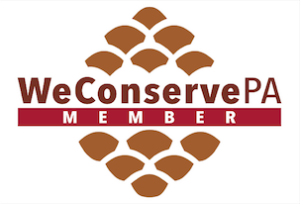There are many possibilities for Eagle Scout or community projects at WLT properties! A small sample of possibilities follow, but if you would like to undertake another project please contact WLT with your ideas.
Possibilities for Eagle Scout or Community Projects
Otto and Magdalene Ackermann Nature Preserve
The 59-acre Otto and Magdalene Ackermann Nature Preserve is a hidden treasure of western Westmoreland County, located at 13270 Ardara Road, North Huntingdon Township – not far from the intersection of Routes 30 and 48.
The Preserve is a beautiful property with a healthy forest and understory. It holds trails and several features of special interest including a scenic stone quarry dating from at least 1867, small waterfalls, a tributary to Brush Creek and its floodplain, steep slopes, the site of a 1975 crash landing of a small place (with no injuries resulting), and a pet cemetery.
The Preserve was among the first properties conserved by the Westmoreland Land Trust (WLT). It was donated to Westmoreland County by the Ackermann family after their maintenance of the property as a nature reserve for many years. Today WLT manages the Preserve to conserve and enhance the quality of its wildlife habitat and also enhance the quality of visitors’ experiences at the Preserve.
A project at the Preserve will be an excellent candidate for an Eagle Scout effort, and will also provide the opportunity to learn about management of natural lands. Project possibilities include – but are not limited to – the following:
- Building a new trail across a hillside. It will involve working with stakeholders to plan and mark the alignment, and then coordinating volunteer effort to cut the benched trail along the alignment. It would also involve removal of invasive plants in the vicinity of the trail, and may involve special measures to reduce potential for erosion of some segments of the trail.
- Improving steep portions of the Wedding Trail, to potentially reduce cross slope and grade at steep portions, and improve drainage and trail stability in wet portions.
- Undertaking control of Japanese knotweed throughout the Preserve’s flood plain of Blue Dell Run, a tributary to Brush Creek, as well as stiltgrass impinging upon native trees that have been planted in the floodplain. The project would include involve cutting the knotweed to a height of 6” – 10” in May or June; later in the year WLT will engage a professional to treat the plants with an herbicide. Control of stiltgrass would entail pulling it out and leaving it on site unless seeds are starting to form; if they are starting to form, the stiltgrass should be bagged, and the bags disposed of off-site.
Twin Lakes Meadow
WLT has partnered with Westmoreland County Parks and Recreation and PA Master Naturalist volunteers to create a meadow of native wildflowers and grasses. This 17-acre meadow is just north of and adjacent to the Twin Lakes Expansion Area on Georges Station Road, Greensburg. The meadow was planted in 2021 to build knowledge about meadow plantings, create an attractive and ecologically friendly destination for visitors, and provide a site for students’ research and education.
As the meadow matures, some wildflowers will proliferate in certain areas, while others will not. The meadow will provide a dynamic landscape for observing this natural progression, a site to visit for walks on mowed paths, a destination for birding and other nature observation, and a good place for photo opportunities.
Project possibilities include – but are not limited to – the following:
1. Placement of nest boxes to enhance the habitat value of the area.
2. Working to control Canada thistle, an invasive and noxious weed, in the Meadow.
Cabin Hill Nature Preserve
Cabin Hill is a nature preserve of about 3-1/2 acres, located off of Cabin Hill Drive near the northern edge of the City of Greensburg. The Preserve is a woodland that has been impacted over the years by nearby construction. There are presently no trails through the preserve, nor a well-defined entrance area. To date the WLT has concentrated on removal of rubbish and selective control of invasive plants at this site. Similar work is still warranted, and the site is easily manageable because of its relatively small size.
Project possibilities include – but are not limited to – the following:
- Planning and purchasing 2 signs for the Preserve – 1 sign to acknowledge state grant funding, and 1 displaying the name of the Preserve – and building supports for them, and placing them at the Preserve.
- Conducting an inventory of vegetation with the Preserve, and creating a map with information about plant and tree populations.
Schwarz Nature Preserve and Sculpture Park
The 96-acre Schwarz Farm located at 504 Beech Hills Road, just north of Greensburg, will become a nature preserve and art park. This extremely scenic property features rolling topography and fields that are currently farmed while plans are made for the property’s development.
Project possibilities include – but are not limited to – the following:
- Adopting a portion of the property’s woods for control of damaging invasive plants.
- Trail design and construction through one portion of the property’s woods, that would also entail removal of undesirable vegetation along the alignment of the trail.
- Clearing invasive plants and debris from a hedgerow/treeline that runs along the back border of the back yard of the farmhouse, and establishment of a gathering area with available log seats.
- Planning and building a new trail through one wooded area adjacent to the north field of the property.
- Creating a photo inventory of boundary pins, with a photo, descriptive information, and geolocation for each pin.
St. Xavier Nature Preserve
The 248-acre St. Xavier Nature is located along Route 30 just west of the Arnold Palmer Regional Airport. WLT is now working on a Master Plan for the nature preserve. This historical site presents many possibilities for projects.
Project possibilities include – but are not limited to – the following:
- Designing and building furniture-quality illuminated light boxes to display old stained-glass windows in one room of the Preserve’s dwelling “Bellbrook”.
- Creating a photo inventory of boundary pins, with a photo, descriptive information, and georeferenced location for each pin.



